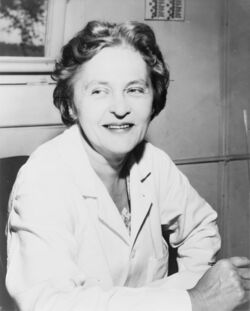Biography:Mária Telkes
Mária Telkes | |
|---|---|
 Mária Telkes in 1956 | |
| Died | 2 December 1995 (aged 94) |
| Nationality | Hungary |
| Known for | Thermoelectricity |
| Awards | National Inventors Hall of Fame |
| Scientific career | |
| Fields | Physics |
| Institutions | Cleveland Clinic Foundation, Westinghouse, Massachusetts Institute of Technology, New York University, University of Delaware |
Mária Telkes (December 12, 1900 – December 2, 1995) was a Hungarian-American biophysicist, scientist and inventor who worked on solar energy technologies.[1]
Telkes is considered one of the founders of solar thermal storage systems, earning her the nickname "the Sun Queen".[2]
She was a prolific inventor of practical thermal devices, including a miniature desalination unit (solar still) for use on lifeboats, which used solar power and condensation to collect potable water. The still saved the lives of airmen and sailors who would have been without water when abandoned at sea.[1]
She moved to Texas in the 1970s and consulted with a variety of start-up solar companies, including Northrup Solar, which subsequently became ARCO Solar, and eventually BP Solar.
Early life and education
Born in Budapest, Hungary, in 1900 to Aladar and Maria Laban de Telkes, Maria attended elementary and high school in Budapest. She then studied at the University of Budapest, graduating with a B.A. in physical chemistry in 1920 and a PhD in 1924.[3]
Career
When she moved to the United States in 1925, she visited a relative who was the Hungarian consul in Cleveland, Ohio. There, she was hired to work in at the Cleveland Clinic Foundation to investigate the energy produced by living organisms. Telkes did some research while working at the foundation, and under the leadership of George Crile, they invented a photoelectric mechanism that could record brain waves and also worked to write a book called Phenomenon of Life.[3]
Telkes worked as a biophysicist in the United States; and, from 1939 to 1953, she was involved in solar energy research at Massachusetts Institute of Technology.
During World War II, the United States government, noting Telkes's expertise, recruited her to serve as a civilian advisor to the Office of Scientific Research and Development (OSRD).[3] There, she developed a solar-powered water desalination machine. It came to be one of her most notable inventions because it helped soldiers get clean water in difficult situations and also helped solve water problems in the US Virgin Islands.[4]
Dover Sun House
In 1948, she started working on the Dover Sun House; she teamed up with architect Eleanor Raymond, with the project financed by philanthropist and sculptor Amelia Peabody.[5] The system was designed so that a special salt would melt in the sun, trap the heat and then release it once it cooled and hardened.
The system worked with the sunlight passing through glass windows, which would heat the air inside the glass. This heated air then passed through a metal sheet into another air space. From there, fans moved the air to a storage compartment filled with the salt (sodium sulfate). These compartments were in between the walls, heating the house as the salt cooled.[5]
Other Work
In addition to this, she received a grant by the Ford Foundation of $45,000 to develop a solar-powered oven so people who lack the technology around the world be able to heat things.[6] The criteria for this project was that the oven needed to be able to get as high as 350 degrees, and needed to be easy to use. The result was an innovation that worked even better than anticipated. It was useful for tribal Indian usage in remote reservations. There were extra safety features so that children could use them. While she invented the solar oven, she also discovered a better way for farmers to dry their crops using the same technology. This technology was extremely important for society as a whole and is still used today.[7] Later in 1980, she helped the US Department of Energy to develop and build the first fully solar-powered home. She received multiple awards for her work, and over the course of her career, earned more than 20 patents.[8]
One of her specialties was phase-change materials, including molten salts to store thermal energy. One of her materials of choice was Glauber's salt (sodium sulfate).
Awards
- 1945 – OSRD Certificate of Merit for the Desalination Unit[3]
- 1952 – Society of Women Engineers Award
- 1977 – American Solar Energy Society, Charles Greeley Abbot Award
- 2012 – Induction into the National Inventors Hall of Fame
References
- ↑ 1.0 1.1 "Maria Telkes". http://invent.org/inductee-detail/?IID=468. Retrieved 4 February 2015.
- ↑ Elizabeth H. Oakes (2007). "Maria Telkes". Encyclopedia of World Scientists. Infobase Publishing. p. 714. ISBN 978-1-4381-1882-6. https://books.google.com/books?id=uPRB-OED1bcC&pg=PA714.
- ↑ 3.0 3.1 3.2 3.3 "Telkes, Maria | Encyclopedia.com". https://www.encyclopedia.com/history/encyclopedias-almanacs-transcripts-and-maps/telkes-maria.
- ↑ "Mária Telkes | American physical chemist and biophysicist" (in en). https://www.britannica.com/biography/Maria-Telkes.
- ↑ 5.0 5.1 Guerra, Tiffany (2016-04-24). "Year of Women in History: Maria Telkes, Chemist and Inventor". http://yearofwomenshistory.blogspot.com/2016/04/maria-telkes-chemist-and-inventor.html.
- ↑ "Maria Telkes | Lemelson-MIT Program". https://lemelson.mit.edu/resources/maria-telkes.
- ↑ Dr. Mária Telkes: A Bright Inventor. Future Science Leaders: Discover - Surrey Session. (2019, March 14). https://www.futurescienceleaders.com/surrey1/2019/03/14/dr-maria-telkes-a-bright-inventor/.
- ↑ Global, C. P. A.. "World-changing Women Innovators | MARIA TELKES" (in en-gb). https://www.cpaglobal.com/women-innovators/maria-telkes.
External links
- "Maria Telkes Resources". solarhousehistory.com. http://solarhousehistory.com/resources/#Maria-Telkes.

